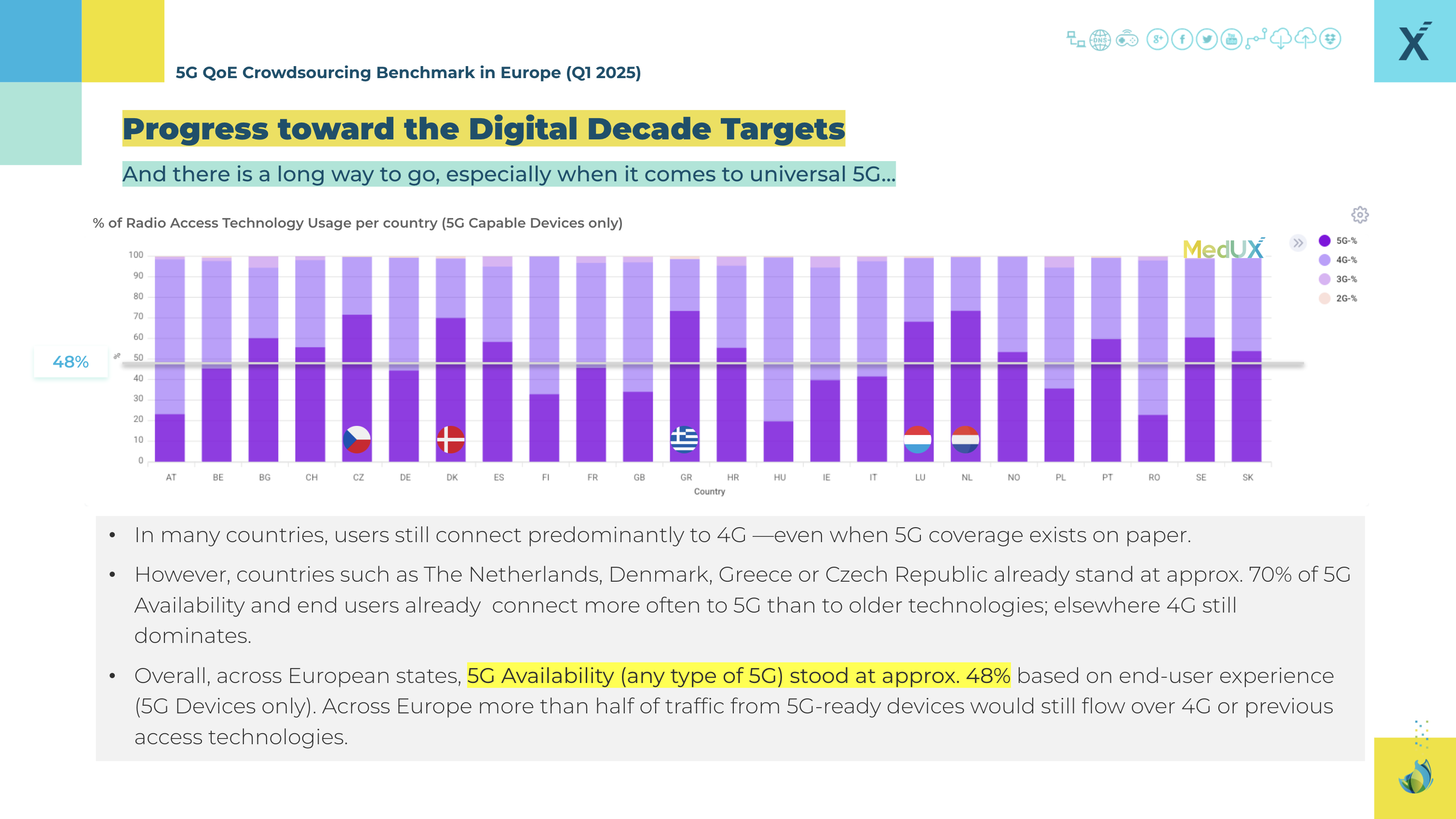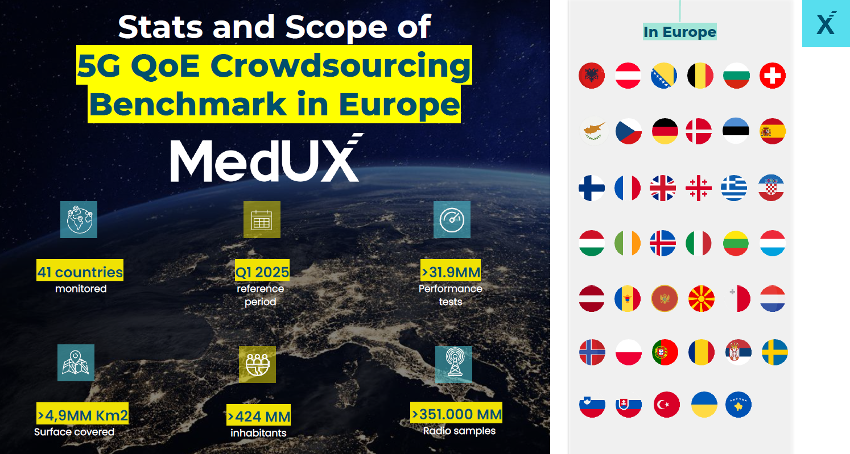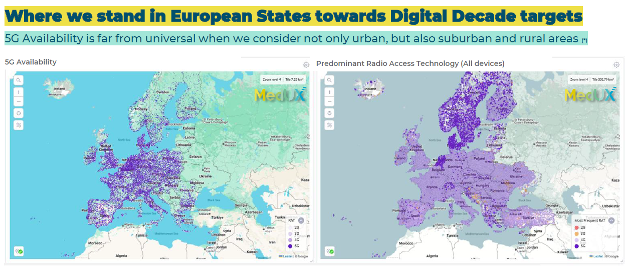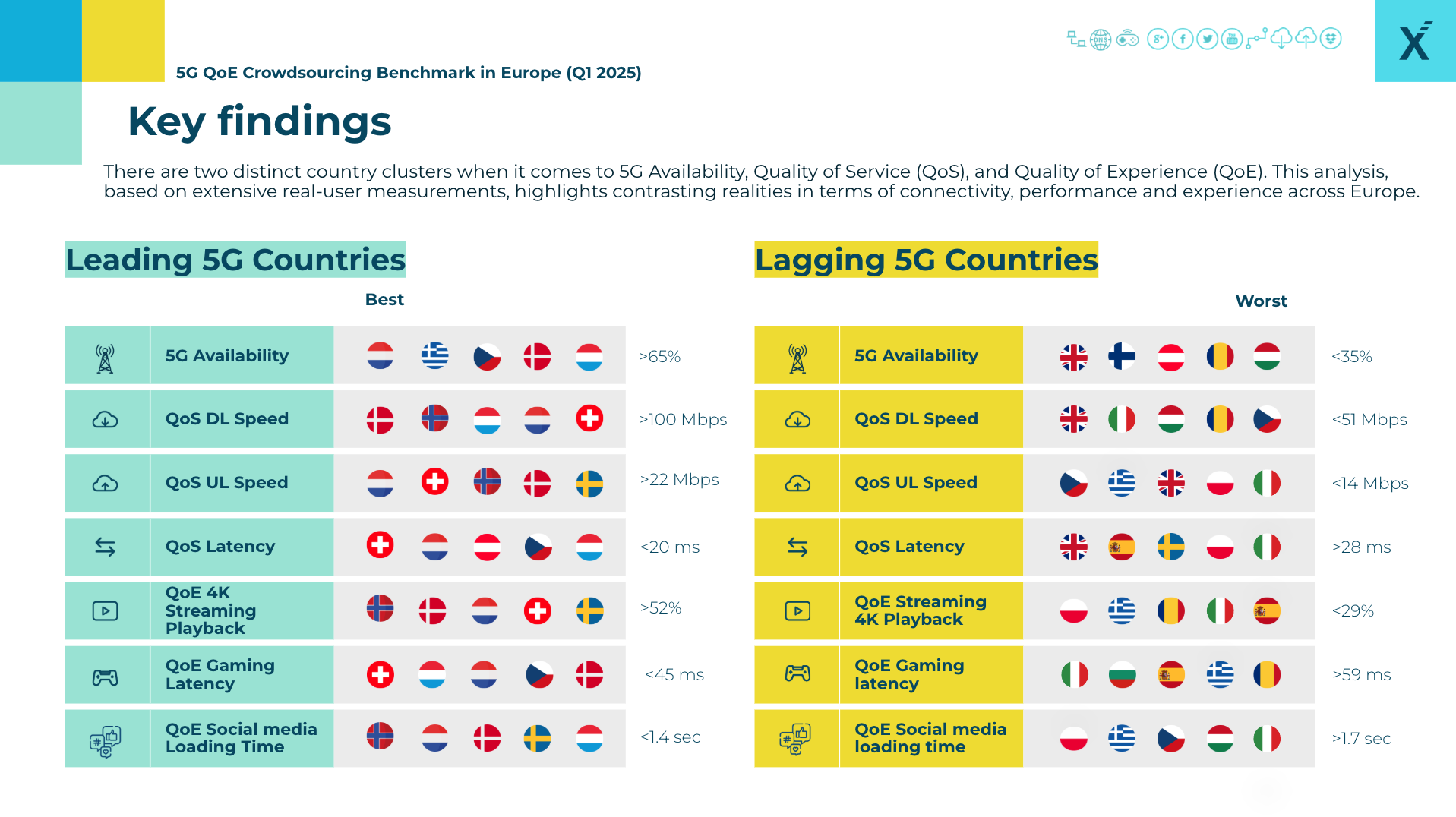Europe’s 5G Progress: Are We Meeting Expectations?

Which European country leads in 5G adoption and QoE performance – and who is falling behind
As Europe races towards its ambitious 2030 Digital Decade goals, questions remain about the real state of connectivity on the ground. Earlier this month, the European Commission released its State of the Digital Decade report, showcasing impressive achievements in household 5G coverage (over 94%) and fiber rollouts, yet also flagging persistent gaps in mid-band deployment, 5G Standalone (5G SA) adoption, and meaningful Quality of Experience (QoE) for citizens and businesses.
At MedUX, we see connectivity not just as a statistic, but as an enabler of societal progress. That’s why we continue to ask: Is Europe’s 5G truly delivering on its promise to transform industries, bridge the digital divide, and empower smart cities?
Earlier this year, in February 2025, our III 5G QoE benchmark across European capitals revealed how cities compare when tested with our MedUX Mobile Robots. But networks do not exist only in urban cities or in test environments. To complement this perspective, we now unveil findings from our massive crowdsourced dataset—millions of real-user data points capturing how people actually experience 5G and digital services in their daily lives.
Why does this matter?
As MedUX highlighted in recent discussions at the European Spectrum Management Conference, achieving the Digital Decade’s vision of a Gigabit Society is not just about theoretical coverage or peak speeds. It requires:
- Advanced 5G rollouts beyond DSS and NSA, enabling ultra-low latency use cases, network slicing, and industrial applications.
- Real user-centric insights to guide smart investment, policy decisions, and technology evolution.
- Equity and inclusion, ensuring that rural regions and underserved communities benefit from the same digital opportunities as urban hubs.
However, our data reveals a stark reality: despite widespread claims of “5G coverage,” many European users still rely predominantly on 4G networks (52% of total connections occur on non 5G networks). Even where 5G is available, Standalone and 5G networks deployments on high-performance 3.4–3.8 GHz C-Band remain scarce, limiting the transformative potential of next-generation services.

To deliver on 5G’s promises, we must measure what matters: real experience, not just availability.
In this report, Status of 5G Quality and Experience in Europe, obtained out of billions of real data samples, we analyze:
- 5G and 5G SA availability as experienced by users with 5G-capable devices
- Performance of everyday services: video streaming, gaming, social media
- 5G and QoE leadership examples
- The difference between leading and lagging countries in Europe’s 5G Quality of Experience landscape
These findings complement the European Commission’s policy objectives, offering an empirical lens to support better planning, investment prioritization, and public communication strategies.
Stay tuned as we share key highlights below and explore what Europe must do next to turn its 5G vision into a reality that empowers everyone, everywhere.
Download the full report for detailed insights here.
Scope of MedUX’s 5G QoE Crowdsourcing Benchmark in Europe
MedUX continues its commitment to revealing the real Quality of Experience (QoE) of 5G networks across Europe. Following our previous benchmarking campaigns with active testing robots, this new crowdsourcing-based study provides a complementary and large-scale perspective to understand how 5G is truly experienced by users.

This first-of-its-kind 5G QoE Crowdsourcing Benchmark in Europe analyses real usage data collected during Q1 2025, covering over 40 European countries, including all major markets and emerging 5G deployments. In total, the study is based on:
- More than 31.9 million performance tests
- Over 351 billion radio samples
- An area covering >4.9 million km²
- A population of more than 424 million inhabitants
Our innovative crowdsourcing approach combines active and passive data collection across real devices, networks, and locations, enabling a holistic understanding of 5G and 5G Standalone (5G SA) availability, bands usage, Quality of Service and Quality of Experience metrics.
This benchmark represents the most extensive crowdsourced evaluation of 5G in Europe to date, reaching billions of samples and millions of users.
MedUX invites both public and private stakeholders to leverage these insights. Our mission is to support operators, regulators, public administrations, smart cities and policymakers in bridging the digital divide, accelerating progress towards Europe’s Digital Decade 2030 goals, and ensuring that 5G networks deliver meaningful user experiences that truly empower societies.
If you would like to learn more about the detailed results in your country or region, operator, or explore how MedUX can help enhance network performance and customer satisfaction, please contact us or request the full report.
Download the full report for detailed insights here.
Key Findings of our report “Status of 5G Quality and Experience in Europe
Our latest study reveals significant disparities in 5G quality and user experience across Europe. While the European Commission’s Digital Decade Strategy sets an ambitious vision for a “Gigabit Society for All” — targeting universal 5G coverage in urban areas by 2025 and in populated areas by 2030 — our data shows that current end-user realities remain far from these goals.
Leveraging billions of real-world crowdsourced data points, MedUX provides an unparalleled view of how 5G networks actually perform, not just on coverage maps but in people’s daily lives.
The MedUX European 5G and QoE Crowdsourcing Report highlights several key findings.
- 5G Availability remains highly uneven. Countries like The Netherlands, Greece, Czech Republic, Denmark, and Luxembourg lead the way, each with more than 65% 5G technology registration rates. The Netherlands in particular stands out, with 5G becoming the predominant access technology (above 73%) thanks to advanced network deployments and accelerated adoption.
- Yet, the European average remains below 50%, and in many areas, especially outside dense urban cores, 4G continues to dominate daily connectivity.

- However, much of Europe’s 5G deployment remains “basic 5G”, heavily reliant on Dynamic Spectrum Sharing (DSS) and low-band frequencies. Our study highlights that usage of the high-performance 3.4–3.8 GHz C-Band averages only 25%, underscoring the untapped potential of mid-band spectrum for true 5G performance.
- True 5G Standalone (5G SA) deployments lag behind. Only a handful of countries — including Spain, Czech Republic, Portugal, Greece, and Austria — show signs of early 5G SA adoption, but even here, the usage share rarely exceeds 1.6% of total traffic. This highlights how much of today’s “5G” experience still relies on legacy 4G infrastructures.
- High-performance C-Band coverage is still limited. Switzerland, Bulgaria, Spain, Portugal, and France outperform the rest with C-Band availability above 37% — yet many networks fail to fully unlock the mid-band’s potential for speed and capacity.
The report also underscores that while download and upload throughput offers considerable benefits over 4G, true Quality of Experience extends far beyond speed. The MedUX analysis delves into critical user-centric metrics such as streaming performance, social media loading times, and gaming experience, revealing significant variations across countries and operators. The findings show that speed alone will not guarantee quality.
- Denmark takes the crown for download speed, averaging 155 Mbps, followed closely by Norway, Luxembourg, the Netherlands, and Switzerland.
- For upload speeds, the Netherlands, Switzerland, Norway,Denmark, and Sweden lead with averages higher than 22 Mbps.
- In network responsiveness, Switzerland, the Netherlands, Austria, Czech Republic, and Luxembourg maintain average latencies under 20 ms, delivering a more stable real-time experience.
Quality of Experience reveals more contrasts:
- For 4K streaming, Norway, Denmark, Netherlands, Switzerland, and Sweden demonstrate the higher 4K playback percentage with values above 52%.
- In Gaming, Switzerland, Luxemburg, the Netherlands, Czech Republic and Denmark stand out with average latencies scores below 45 ms
- For social media, Norway, the Netherlands, Denmark, Sweden, and Luxembourg perform best with average loading times below 1.4 seconds, ensuring a smoother everyday experience.
- Both Netherlands and Switzerland consistently demonstrate remarkable performance, being among the leading countries:
- The Netherlands ranks first in 5G availability (73%) and upload speeds (31 Mbps). Additionally, it is among the top 5 in latency, streaming 4K playback, gaming latency and social media loading time, positioning itself as a European leader in overall 5G Quality of Experience.
- Switzerland takes the lead in both latency (an average of 16 ms), and gaming latency (an average of 32 ms). It is also among the top 5 in download speed, upload speed and streaming 4K playback, highlighting its robust 5G quality. It also presents the highest 5G C-band usage with a remarkable 46% in total.
Download the full report for detailed insights here.
However, the findings also confirm stark divides. Some countries, notably Italy, United Kingdom, Greece, Poland and Romania still show download speeds under 50 Mbps, upload rates below 14 Mbps, and latencies well above 28 ms, underscoring a two-speed 5G reality within Europe.

The takeaway?
Europe’s journey to a robust Gigabit Society demands more than wider coverage maps. The gaps between “basic” and “advanced” mid-band 5G deployments, standalone availability, and application-level QoE must be closed if we want to unlock 5G’s full promise for all Europeans.
At MedUX, we believe the time to transform connectivity is now — bridging these divides is not just a technical goal, but a vital step towards digital inclusion, economic competitiveness, and sustainable growth across Europe.
Discover more about our methodologies, insights, and how MedUX is shaping the future of 5G connectivity.
To learn more about our 5G use cases on competitive intelligence, pre- and post-rollout analytics, and basic troubleshooting, and how they can benefit your business, please visit our website at www.medux.com .
For detailed country, region and operator specific insights and comprehensive data from our European 5G QoE performance crowdsourcing study, contact us at hello@medux.com.
Methodology
The crowdsourcing campaign collects real-time mobile network data via a Software Development Kit (SDK) embedded into real mobile applications used by millions. MedUX’s global panel of millions of devices enables a robust and statistically representative view of mobile network performance at national, regional, and operator-specific levels, capturing unmatched granularity of the end-user experience.
Data is collected from a wide array of real-world conditions, covering urban and rural areas, indoor and outdoor environments, and users in motion or stationery. Detection and exclusion of anomalous or corrupted samples, followed by the removal of duplicate entries, identifying and filtering extreme values in both signal metrics and active test results, which may result from atypical environmental or device-specific anomalies.
More than 100 KPIs are collected, covering from device and connection data to performance metrics such as download and upload speeds, latency, video streaming and VoIP performance.
For each country analysed, MedUX ensures that the number of samples and users meets the statistical conditions necessary to report with confidence. Specifically, key performance indicators (KPIs) are calculated with a 95% confidence level and a maximum margin of error of ±5%, derived from the national-level sample size and distribution.
For more details on the methodology please see the report.
Don’t forget to follow us on social media and subscribe to our newsletter to receive the latest updates and news.
Follow us on:
About MedUX
MedUX is the leading Quality of Experience (QoE) company, providing comprehensive and innovative solutions for measuring the performance of fixed, mobile, and TV telecommunications networks for telecom operators, governments, and digital enterprises. With a focus on delivering grand scale, end-to-end network, and service visibility, MedUX leverages real-time customer perspective data and advanced analytics to ensure quality and regulatory compliance, while also offering valuable insights for optimizing networks and improving customer experiences. With a presence in over 25 countries across Europe, America, Africa, and the Middle East, and monitoring over 60 operators worldwide, MedUX’s patented technology and expertise make it a trusted partner for improving the digital experiences of customers everywhere.


